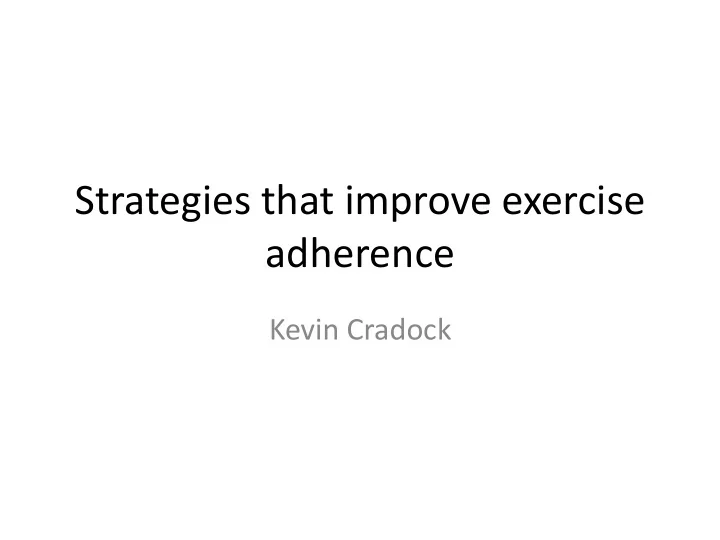

Strategies that improve exercise adherence Kevin Cradock
Changing Times? “For 99.9% of human history, physical demands were typical of daily life and expected part of the everyday world” (Astrand, 1986) “Our species not only survived but flourished for several thousand generations prior to the advent of the automobile, television, video games and Internet. Within only a few generations, the physical activity demands of work, domestic chores and leisure time have decreased so dramatically as to be nearly non-existent in industrialised and urbanised environments” (Sparling et al., 2000).
Recommendations 150 minutes per week (min) 30 mins per day, 5 days per week NHS, WHO, ACSM, EU
Recommendations Problem What we are doing V What we being told to do
Recommendations Don’t be disheartened, any activity, exercise, is better than no exercise. Pick an exercise, movement that you enjoy
Theoretical explanations for behaviour change maintenance 1 Role of motives 2 Self-regulation 3 Resources (psychological and physical) 4 Habits 5 Environmental and social influences Kwasnicka et al 2016
Habits Dr BJ Fogg Tiny Habits 1 Strong commitment 2 Easy goal 3 Trigger it
Contagious Change in 1 habit helps facilitate change in another Adhering to change in one are increases ones belief and helps one towards change in other areas
Results BCTs *BCTs associated with >0.3% reduction in HbA 1c HbA 1c Instruction on how to perform a behaviour -0.549 Behavioural practice/rehearsal -0.417 Demonstration of the behaviour -0.343 Action planning -0.385 Graded Tasks -0.217 Cradock et al 2017 (International Journal of Behavioural Nutrition and Physical activity)
Intervention features Intervention features associated with >0.3% reduction in HbA 1c HbA 1c Supervised physical activity -0.572* Group sessions only -0.448 Contact with exercise physiologist -0.364 Combination of dietitian and exercise physiologist -0.312 Higher Frequency of total contacts -0.658* Higher Frequency of face to face contacts -0.621 Higher number of face to face contacts -0.484 Cradock et al 2017 (International Journal of Behavioural Nutrition and Physical activity)
Habits Monday is a great day to begin, align your exercise to a Monday, instant success Even if the remainder of the week is a disaster begin on Monday Monday is the beginning of the week Start
Action plan Step 1 Desire to do it Commitment
Action plan Step 2 What When Where With who How much
Action plan Step 3 Environment: assess it & identify opportunities Small goal Simple Set a time, hot trigger to do it Anchor it
Power of Habit 1.46 million Kg
Opportunity: Exercising more • When (Anytime) • Where (Anywhere) • What (Anything) • Who (Anyone) • Why (because we can) • How
Summary 1 Make a rock solid commitment 2 Set an easy goal 3 Trigger it 4 Change your environment 5 Do activity that you enjoy
Affiliations & Collaborators Kevin A. Cradock Human Movement Laboratory, NUI Galway, Physiology, School of Medicine, NUI Galway, Electrical & Electronic Engineering, School of Engineering & Informatics, NUI Galway, Professor Gearóid Ó Laighin Electrical & Electronic Engineering, School of Engineering & Informatics, NUI Galway, National Centre for Biomedical Engineering Science, NUI Galway, Dr Francis M. Finucane Bariatric Medicine Service, Galway Diabetes Research Centre, HRB Clinical Research Facility, Professor Kathleen A. Martin Ginis Assistant Professor Heather L. Gainforth School of Health and Exercise Sciences, The University of British Columbia, Canada Dr Leo R. Quinlan Physiology, School of Medicine, NUI Galway,
Contact k.cradock1@nuigalway.ie
References • Cradock KA, ÓLaighin G, Finucane FM, Gainforth HL, Quinlan LR, Ginis KAM: Behaviour change techniques targeting both diet and physical activity in type 2 diabetes: A systematic review and meta-analysis . International Journal of Behavioral Nutrition and Physical Activity 2017, 14 (1). • Cradock KA, ÓLaighin G, Finucane FM, Gainforth HL, Quinlan LR, Ginis KAM: Diet Behavior Change Techniques in Type 2 Diabetes: A Systematic Review and Meta-analysis, under review. • Astrand, P. O. (1986) Why exercise? An evolutionary approach. Acta Medica Scandinavica Supplementum , 711, 241 – 242. • Sparling et al 2000 , Promoting physical activity: the new imperative for public health. Health Educ Res (2000) 15 (3): 367-376. • Kwasnicka D, Dombrowski SU, White M, Sniehotta F: Theoretical explanations for maintenance of behaviour change: a systematic review of behaviour theories. Health Psychol Rev 2016:1-20. doi: 10.1080/17437199. 2016.1151372.
“The secret of change is to focus all of your energy, not on fighting the old, but on building the new” Socrates None of us know the extent of our potential
Recommend
More recommend